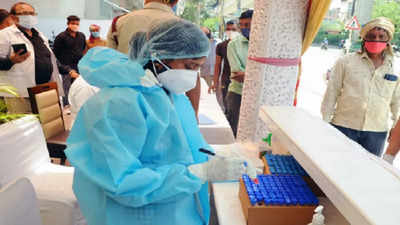- News
- City News
- delhi News
- Covid-19: 9 of 11 Delhi districts in the ‘red’, caution remains the key
Trending
This story is from August 12, 2022
Covid-19: 9 of 11 Delhi districts in the ‘red’, caution remains the key
In the first week of July, three districts of Delhi were in the Orange zone with regard to Covid-19 with the average weekly positivity rate being above 5%. The district with the highest positivity rate — East — was still below 10%. In the first week of August, however, nine of the 11 districts are in the Red zone, all with a higher than 10% weekly positivity rate. Experts believe that without official intervention, the coming festive season could see a rise in infections.

The district with the highest positivity rate — East — was still below 10%.
NEW DELHI: In the first week of July, three districts of Delhi were in the Orange zone with regard to Covid-19 with the average weekly positivity rate being above 5%.
The district with the highest positivity rate — East — was still below 10%. In the first week of August, however, nine of the 11 districts are in the Red zone, all with a higher than 10% weekly positivity rate.Experts believe that without official intervention, the coming festive season could see a rise in infections.

From an overall average weekly positivity rate of 5.3% in early July, the figure went up to 14. 5% in August 1-7, an increase of 9.1%. The most massive jump in the average weekly positivity rate is of Central district, where it has risen from 7.5% to 21.3%. The highest average weekly positivity rate in the first week of July was 9.5% in East district.
With the beginning of the festive season and major celebrations planned around Independence Day, experts feel the number of new Covid cases and positivity rate will spiral. “While we were getting four-five patients a day till recently, we are now getting 15-17,” said Dr Suresh Kumar, medical director, Lok Nayak Hospital. “In most of these cases, the patients are immunocompromised. They already have cancer or tuberculosis, or are undergoing dialysis or have heart failure or have chest problems.”
In almost all the cases, the infected people haven’t had the booster vaccination. “The third precaution dose is a must because six months after the second dose, immunity becomes low. The third dose ensures that the effect of an infection is minimal,” said Kumar.
He added that during the festivals, people had to adopt safety measures against infection and if they were going to crowded places like the market, wearing a mask had to be mandatory.
Dr Lalit Kant, former head of epidemiology, Indian Council of Medical Research, remarked, “Both the people and the government are showing signs of pandemic fatigue and it is very important that the citizens are told the reason why the third dose is important. The immunity level starts to decline three or four months after the second dose and that is why we need to boost the immunity back to the optimum level.”
There is gross underreporting of new cases, Kant opined, with the actual number probably much higher than being recorded. “The vaccination status of vaccinated people should also be shared, but there is a total vacuum of information,” he maintained.
The district with the highest positivity rate — East — was still below 10%. In the first week of August, however, nine of the 11 districts are in the Red zone, all with a higher than 10% weekly positivity rate.Experts believe that without official intervention, the coming festive season could see a rise in infections.

From an overall average weekly positivity rate of 5.3% in early July, the figure went up to 14. 5% in August 1-7, an increase of 9.1%. The most massive jump in the average weekly positivity rate is of Central district, where it has risen from 7.5% to 21.3%. The highest average weekly positivity rate in the first week of July was 9.5% in East district.
Apart from Central, East district too recorded an average weekly positivity rate of more than 20%, while South followed close behind at 19.3%. The only two districts not in the Red Zone are North (6.9%) and North-East (6. 7%).
With the beginning of the festive season and major celebrations planned around Independence Day, experts feel the number of new Covid cases and positivity rate will spiral. “While we were getting four-five patients a day till recently, we are now getting 15-17,” said Dr Suresh Kumar, medical director, Lok Nayak Hospital. “In most of these cases, the patients are immunocompromised. They already have cancer or tuberculosis, or are undergoing dialysis or have heart failure or have chest problems.”
In almost all the cases, the infected people haven’t had the booster vaccination. “The third precaution dose is a must because six months after the second dose, immunity becomes low. The third dose ensures that the effect of an infection is minimal,” said Kumar.
He added that during the festivals, people had to adopt safety measures against infection and if they were going to crowded places like the market, wearing a mask had to be mandatory.
Dr Lalit Kant, former head of epidemiology, Indian Council of Medical Research, remarked, “Both the people and the government are showing signs of pandemic fatigue and it is very important that the citizens are told the reason why the third dose is important. The immunity level starts to decline three or four months after the second dose and that is why we need to boost the immunity back to the optimum level.”
There is gross underreporting of new cases, Kant opined, with the actual number probably much higher than being recorded. “The vaccination status of vaccinated people should also be shared, but there is a total vacuum of information,” he maintained.
End of Article
FOLLOW US ON SOCIAL MEDIA










